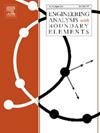多连通域中高阶 Helmholtz 型 PDE 的带鬼点的边界结方法
IF 4.2
2区 工程技术
Q1 ENGINEERING, MULTIDISCIPLINARY
Engineering Analysis with Boundary Elements
Pub Date : 2024-10-28
DOI:10.1016/j.enganabound.2024.105998
引用次数: 0
摘要
本文提出了带鬼点的边界结方法(BKM-G),它提高了 BKM 在求解具有多个空腔的域中的二维(三维)高阶 Helmholtz 型偏微分方程时的性能。BKM-G 与传统的 BKM 不同,它将源点从边界配准节点迁移到一个随机区域,如一个环绕原始二维(三维)域的圆(球)。与经典 BKM 相比,这种修改在不牺牲简单性和效率的前提下提高了精度。此外,本文还研究和分析了 BKM-G 中幽灵圆/球半径 R 对求解各种高阶 Helmholtz 型 PDE 的影响。大量二维和三维数值示例表明,BKM-G 在很大的 R 范围内都优于 BKM。此外,还研究了经济 ECN(EECN),以显著提高 ECN 的效率。本文章由计算机程序翻译,如有差异,请以英文原文为准。
Boundary Knots Method with ghost points for high-order Helmholtz-type PDEs in multiply connected domains
This paper proposes the Boundary Knot Method with ghost points (BKM-G), which enhances the performance of the BKM for solving 2D (3D) high-order Helmholtz-type partial differential equations in domains with multiple cavities. The BKM-G differs from the conventional BKM by relocating the source points from the boundary collocation nodes to a random region, such as a circle (sphere) encompassing the original domain in 2D (3D). Compared with classical BKM, this modification improves accuracy without sacrificing simplicity and efficiency. Moreover, this paper investigates and analyzes the effect of the ghost circle/sphere’s radius in BKM-G for solving various high-order Helmholtz-type PDEs. Numerous 2D and 3D numerical examples illustrate that the BKM-G outperforms the BKM for a wide range of . The effectiveness of the proposed effective condition number (ECN) approach in finding the optimal has also been demonstrated. Furthermore, the economic ECN (EECN) is studied to significantly improve the efficiency of ECN.
求助全文
通过发布文献求助,成功后即可免费获取论文全文。
去求助
来源期刊

Engineering Analysis with Boundary Elements
工程技术-工程:综合
CiteScore
5.50
自引率
18.20%
发文量
368
审稿时长
56 days
期刊介绍:
This journal is specifically dedicated to the dissemination of the latest developments of new engineering analysis techniques using boundary elements and other mesh reduction methods.
Boundary element (BEM) and mesh reduction methods (MRM) are very active areas of research with the techniques being applied to solve increasingly complex problems. The journal stresses the importance of these applications as well as their computational aspects, reliability and robustness.
The main criteria for publication will be the originality of the work being reported, its potential usefulness and applications of the methods to new fields.
In addition to regular issues, the journal publishes a series of special issues dealing with specific areas of current research.
The journal has, for many years, provided a channel of communication between academics and industrial researchers working in mesh reduction methods
Fields Covered:
• Boundary Element Methods (BEM)
• Mesh Reduction Methods (MRM)
• Meshless Methods
• Integral Equations
• Applications of BEM/MRM in Engineering
• Numerical Methods related to BEM/MRM
• Computational Techniques
• Combination of Different Methods
• Advanced Formulations.
 求助内容:
求助内容: 应助结果提醒方式:
应助结果提醒方式:


